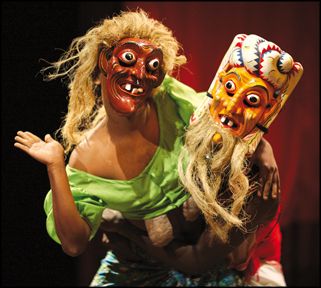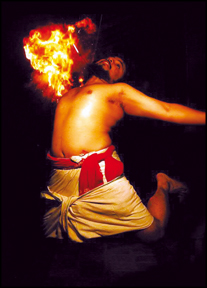A dazzling performance that brought honour to the nation
by Ranga CHANDRARATHNE
 Relatively unknown to Edinburgh Fringe Festival, the most celebrated
theatre festival in the world, Ranganika (Island of Dance) a production
by Arakavila Theatre Foundation has marked Sri Lanka’s name not only at
the festival securing four star rating but also among thousands of fans
who attended the festival. Owing to the unique Sri Lankan dances such as
Asadrusha Vannama, Nonchi Kolama, the performance attracted scores of
reviews in leading newspapers in Scotland including Scotsman. In fact,
with its dedicated troupe and colourful costumes, Arakavila Theatre
Foundation has stalled the show among many contenders from across the
world. Apart from the unique exposure to international audience, the
members of the troupe had brought home tonnes of invaluable experiences
together with a lot of goodies to their kith and kin. Relatively unknown to Edinburgh Fringe Festival, the most celebrated
theatre festival in the world, Ranganika (Island of Dance) a production
by Arakavila Theatre Foundation has marked Sri Lanka’s name not only at
the festival securing four star rating but also among thousands of fans
who attended the festival. Owing to the unique Sri Lankan dances such as
Asadrusha Vannama, Nonchi Kolama, the performance attracted scores of
reviews in leading newspapers in Scotland including Scotsman. In fact,
with its dedicated troupe and colourful costumes, Arakavila Theatre
Foundation has stalled the show among many contenders from across the
world. Apart from the unique exposure to international audience, the
members of the troupe had brought home tonnes of invaluable experiences
together with a lot of goodies to their kith and kin.
Ranganika was made up of six items including folk dance, devil dance,
torch dance, a ‘Vannam’ from Up Country dance while ‘Vadigapaduna’ from
low country dance and a creation based on ‘Kolam’. ‘Rananika’ team
consists of 18 students. Among the Vannam in the Ranganika Asadrusha
Vannama is prominent. It has a special place among the 18 dances of this
genre in the upcountry dance tradition. Originally these poetical
creations were meant to be chanted at meetings of poets gathered in the
city of Kandy for poetic dialogue. Later they came to be choreographed
as dance forms expressive of the meaning of each Vannama.
The ‘Asadrusha Vannama’ serves to invoke the blessings of the triple
gem and gods at the commencement of a dance recital. It is a paean to
the virtues of the triple gem.
Wadiga Patuna is another spectacular item in Ranganika. It is a
spectacular form of dance among the ritualistic dance forms such as
Suniyam, a principle dance form in the thovil which is a common type of
dance in the Low Country Dance Tradition and also known as Suniyam
Yagaya, Suniyam Kepilla and Menikpala Yagaya.
According to legend, the Brahmins from the land of Wadiga arrived in
Sri Lanka to dispel a Suniyama, a curse by Mara, the God of death, on
queen Menikpala on the invitation of king Mahasammata who was considered
as the world’s first dancer.
Wadiga Patuna is a dance which recreates the arrival of Wadigas to
Sri Lanka. There is another school of thought that Wadigas could not
cure the queen and they arrived in Sri Lanka for a ritual not for a
Suniyam.
Nonchi Kolama (A dance evoking sense of irony) which is unique to Sri
Lanka had attracted attention of the reviewers. Nonchi Kolama occupies
the pride of place in Low Country Dance tradition. An oval-shaped
threshing floor (Kamatha) following the harvesting of the paddy is used
for the performance of Nonchi Kolama.
One of the salient features of the Nonchi Kolama is complex emotions
are expressed by only gesticulations as facial expressions are not
possible with masks on. Nonchi, an ugly woman tries hard to portray
herself as astounding beauty and her attempts generate irony.
A tom-tom beater exposes an officer. Nonchi comes with her two
children and tries to drag home her heavily intoxicated husband which
creates the crux of the performance.
A dance to god Dholaha (Thelamy) was another item which made the
performance colourful. In the low country dance tradition, the main
dance ritual is performed in a specially constructed hut. Of the various
dance rituals performed in the hut, the principal dance is done in the
name of God-Dholaha. It is called “Thelmay”.
Of the costumes in the low-country dance tradition, a special costume
decorated with beads is used for “Thelmay”. The dance is rhythmic and
dignified and it includes features such as artistic twirling, leaping
and somersaulting. So energising is it to watch, that it spontaneously
draws members of the audience to join the dance.
 |
|
Nonchi Kolama |
Perhaps, ‘The Village Life’ was the item which depicted the village
life in terms of folk dance and folk songs. The village life which is
based on agriculture, is always associated with See-pada (four-stanza
poems), Goyam Netum (dances associated with reaping of paddy), Kalagedi
Netum (dancing with pots) and Lee Keli (dance with clubs) which help
spell out the weariness of the farm-hands.
The cast of Ranganika (The Land of Dance) comprised (dancers) Janaki
Hill, Ruksala Roshani, Kosala Harshani, Lakshani Sandarenu, Jayani
Koshila, Kushmanthi Thilini, Nilantha Sanjeewa, Randika Kasun Nilakshana,
Isuru Chathuranga, Janaka Maduranga, Suchitha Mangala, Asiri Madusanka,
Denesh Madushanka, (Drummers) Pabalu Erange, Chathuranga Chitrajith,
Ranga Nuwantha and Buddika Hasantha. The choreography and costume
designed for Ranganika was by Janaki Hill.
According to the members of the troupe, from embarking on to the
flight to their stay in Scotland and return to Sri Lanka. Troupe
received heartiest greetings. For instance, cabin crew of the flight
offered Ranganika team with best they could afford in terms of
hospitality. The troupe’s stay at the festival venue was comfortable
with a cook in attendance. This would have given them more practising
space. Since the schedules were planned in such a way that the troupe
get one or two off days, had also contributed to spectacular show which
was rated as four star.
It should be mentioned here that five star rating is the highest
which even most of the professional teams have failed to achieve. Sri
Lankans in the city of Edinburgh who are either students or domiciled
there, were conspicuous in their continuous presence for Ranganika.
Parading the streets sporting colourful costumes would have been fun and
frolic as well as a novel experience for the troupe which is quite not
possible in Sri Lanka.
Arakavila Dance and Theatre Foundation (ADTF) was set up in 2008.
However, the activities including theatre workshops of the foundation
have been carried out under the banner of ‘Diriya Daruwo’ since 2006.
Earlier the objective was to conduct a programme to develop
leadership skills of the students. A workshop titled Leadership Training
and Motivation Programme was conducted in diverse parts of the country.
The practical workshop sans paper work was aimed at eliminating stage
freight of the students, developing their leadership qualities and
building team spirit on the platform of dance and theatre.
In addition to the workshop, Peter Hill and Mrs. Janaki Hill granted
30 scholarships to children of the village with single parents; either
mother or father, for their education. The monthly scholarships which
bear the recipients’ expenses for education will continue until they
conclude their education.
Subsequently, with the sponsorship of SriLankan Airlines, the
Workshop was conducted in 12 regions of the Island with the
participation of students from 250 schools. Since the majority of
students are from the village of Arakavila, ‘Diriya’ ‘Daruwo’ was
re-launched as Arakavila Dance and Theatre Foundation registered under
the Company Act No 7 of 2007 with registration number of J.A.287 and
also pending registration with the Ministry of Cultural Affairs.
The intense competition for education has deprived present day
children of childhood and gone are the days children enjoyed excursions
into the forests and pluck succulent wild fruits like ‘Dan’ (an
indigenous fruit similar to berry in Europe) and watching fish like
‘Handaya’ (a fish with a moon-like dot on its head) in the canals of the
village. Children of today are engaged in a rat race where they attend
school from morning to evening and thereafter attend private tuition
classes only to return home late in the evening with a satchel which is
bigger than the children themselves!
One of the noble objectives of the Foundation is to give back the
children the joys of childhood through dance, theatre and other forms of
visual and performing arts.
Presently, the Foundation conducts workshops on traditional Up
Country, Low Country, and Indian Classical Dance and on music. In
addition, the Foundation also conducts a Leadership Training Programme
and an English Language Teaching Programmes to improve students’
language and communication skills in English. It also enhances the
creativity on the part of the students and is aimed at training students
in accessing growing body of knowledge based on Art, Culture and
Literature.
The foundation intends to eliminate vice in the village through art
and in preserving traditional forms of arts in their original forms.
Productions of the foundation
The ‘Diriya Daruwo’ is a Leadership Training and Motivation Programme.
Under which a practical workshop with the intention of taping inherent
skills of the children and augmenting them was conducted in diverse
parts of the country. So far, children from over 250 schools have
participated in the workshop.
 |
|
Chalana |
From the responses of the students, it was clear that workshop had
brought about a positive change in the lives of the participants.
‘Chalana’
Chalana is an evening of classical and contemporary dance. It is not
confined to traditional dance but also depicts creations and the concert
is presented in the form of a drama.
The story unfolds in the household of a traditional dance ‘Guru’ who
has a critical outlook on contemporary dance scene that is under the
influence of popular dance forms such as ‘Hip-Hop’. Note: Excerpt from
the Review
‘Faith’
‘Faith’ is a short film about a destiny of a girl with dearth of
education from a lower stratum of the society who has been duped by a
fake lover. She becomes pregnant and the lover, who runs a car sale,
refuses to marry her.
The film ends with the girl being driven crazy by the circumstances
and rendered penniless begging with a girlchild.
Perhaps, the most striking scene is the one where the girl sends her
child to a car stopped on the road and the man was a bit reluctant to
retrieve his purse from his pocket to get some change. The man notices
the woman. The woman notices that it was her ex-lover who had by now,
married a wealthy woman and leads a luxurious life.
He races the engine and vanishes from the scene. The short film is
marked for its brevity in diction and evocative images and visuals
especially where the flashback is employed.
|

